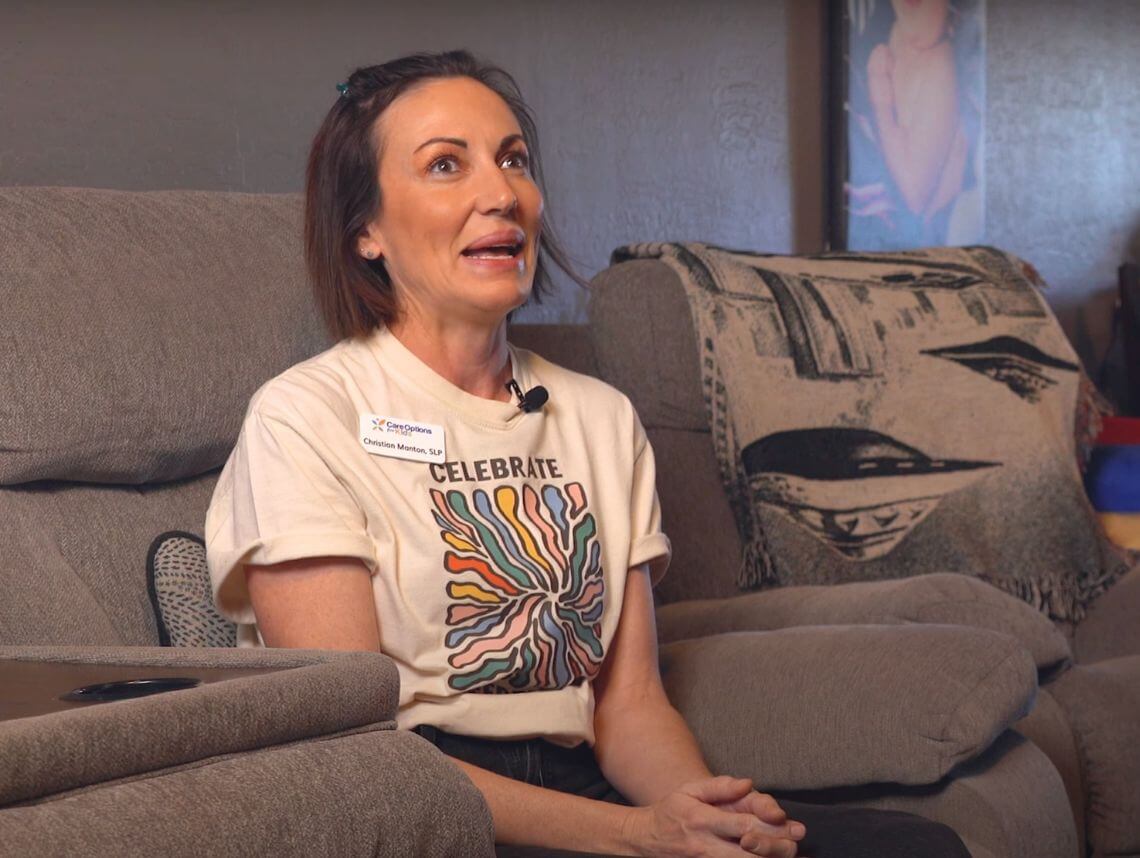Solace Blog
- Activities19
- Autism & Behavioral4
- Community154
- Early Intervention71
- Events & Giving Back20
- Extraordinary Kids22
- Family Caregiver4
- Home Care Therapy60
- News94
- Parent Articles83
- Patient Testimonial21
- Pediatric Therapy77
- Pediatric Therapy Career46
- Private Duty Nursing1
- School-Based Services1
- Telehealth Therapy27
- Tips & Advice66
Summer Reading List: Books to Inspire Therapist Growth
Cooling Off with Aquatic Therapy: Benefits and Best Practices
Sensory Activities For Kids

From School To Home: Christian’s Shift To Impactful Therapy
Speak, Listen, Connect: 6 Communication Strategies for Therapists

Speech Impediments in Children | Rhotacism and Therapy
It is estimated that up to 700,000 students within the American public school system are characterized as having a language or speech impediment. This dynamic tends to be more common in boys than in girls. With that said, using a strict classification, only about 5% to 10% of the population at large speaks in a completely “normal” way. In other words, practically everyone suffers from some type of speech disorder or another. So, please do not become overly distressed if your child is having trouble with speech pronunciation, the most common being connected to the /r/ sound.
Rhotacism Definition
Difficulty pronouncing the /r/ sound is known as rhotacism and it is customarily considered to be a speech impediment. Rhotacism is very common among children because /r/ is one of the most challenging sounds to pronounce in the English language.
The /r/ Sound
The English has many sounds, but surprisingly, one of the most common is the /r/ sound. In fact, there are 32 different variations (known as “allophones”) of the /r/ sound. Each allophone is a separate and distinct sound.
Moreover, the /r/ sound can occur in different places in a word—in the beginning, middle, and end. The /r/ can also be combined with other consonants. For example, /tr/, /br/, /str/, /cr/, /dr/, and so on. The /r/ can occur by itself, as in “run” or “rob”, but it is sometimes the combinations that are tricky for many. For instance, words that contain “ar”, “air”, “eer”, “er”, “or”, “ire”. “star”, “fair, “steer”, “feather”, “foe”, or “fire”.
Each combination poses a challenge because it requires different tongue, jaw, and teeth positions and movements. Thus, it is not surprising that the /r/ sound is one of the last sounds that many children learn to say. While the age varies, the /r/ sound is typically mastered when a child is 6-7 years old.
Simply put, the /r/ sound is a very tricky sound to learn and to correct.
Characteristics of Rhotacism
People with rhotacism typically produce the /r/ sound as a vowel-like sound, and this makes the /r/ word hard to understand. Often the /r/ is pronounced like a “w”. For example, “Roger Rabbit” tends to sound like “Woger Wabbit”.
Rhotacism can also make other sounds difficult to distinguish. By way of example, words that are impacted by a rhotacism include very common words such as red, tire, car, beer, rabbit, ranch, rink, rice, right, ride, ring, rip, seashore, butter, and software.
Causes of Rhotacism
Truth be told, the cause of rhoticism is unknown. There are many theories, but none that are definitive. In some cases, it may be linked to “ankyloglossia” or what is commonly referred to as “tongue-tie”. Tongue-tie tends to limit the range of tongue movements, which is critical for properly forming the /r/ sound.
Then again, there are scientist who theorize that the biggest cause, or influence, is that a child grew up in an environment where they heard the /r’s/ in a weird way, and their lips never learned how to produce the letter. For example, in a child this could happen because the parents (or adults) think that the way the child talks is cute, and they positively reinforce “baby talk” by speaking it back to the child.
Language or Speech Disorder or Impediment?
A speech impediment, such as rhotacism, is a speech disorder, which is distinct from a language disorder. Speech disorders are problems in the ability to pronounce sounds, whereas language disorders are problems with understanding and/or being able to use words. Language disorders have nothing to do with speech pronunciation.
Social Implications of Rhotacism
Children who have trouble forming the /r/ sound may seem less mature than their classmates and may even be victims of bullying and ridicule. This can have a harmful impact on their social and academic performance with far-reaching impacts later in life. In addition, research shows that it is unlikely for a person who struggles with the /r/ sound to learn to produce the sound after high school without speech therapy.
Is Rhotacism Curable?
Speech Language Therapists (SLP’s) have achieved great results in treating rhotacism. An SLP will perform an assessment to determine the extent of the problem and if it can be fixed. SLP’s are trained in predicting if a child can outgrow the problem.
Timely diagnosis and rehabilitation of rhotacism in preschool children is essential for it will enable easier and faster integration of the children in the social and educational environment, without leaving lasting emotional scars and other consequences.
Typically, an SLP will work with the child weekly and require some homework. They will also provide detailed practice instructions to help parents get involved with their child’s therapy. Most experts agree that given the probability of parental influence in the child’s development of rhotacism, it is recommended that the parents become a part of the solution to reverse the previous training. In other words, it is helpful if they agree to no longer encourage “baby talk”.
In the US, it is not uncommon for children with rhotacism, who are in school, to be placed in special education programs. While that is helpful and often very convenient, it also has the downside of taking the child out of their primary learning environment thereby increasing the risk of social stigmatization.
Therapy Strategies.
There are typically 4 stages to rhotacism therapy.
- Awareness. Developing a child’s awareness involves teaching a general understanding of the required movement of the tongue, lips, teeth, and the hard and soft palate. Often an SLP will utilize lollipops (if they’re the fun sort of SLP) or tongue depressors to bring attention to the areas that need to be used.
- Visual Clues. Often a mirror is used to help the child see where the tongue should be placed to improve the /r/ pronunciation. Visual cues are helpful in learning as they provide immediate feedback and reinforcement of proper patterns.
- Coordination and Strengthening Exercises. Sometimes the problem is muscular, and the child needs to strengthen both their jaw and tongue movement. This muscle instability can be reversed and stabilized through varying strength exercises which the SLP can teach the child and teach the parents how to reinforce through practice.
- Rhyming Games. Rhyming words is a standard and fun way to practice the /r/ sound: car jar, roger dodger, roll troll, tribe bribe, and so on. There are many such games that an SLP can teach the child and the parents to encourage proper pronunciation.
- Practice and Expansion Drills. Once a child is successful with producing the proper /r/ sound in a certain context, the SLP will likely increase the complexity by teaching the /r/ sound in other contexts and positions.
Solace Pediatric Home Healthcare Speech Therapists
Solace Pediatric Healthcare is the leading provider of speech therapy services. Since 2005, our SLP clinicians have provided pediatric speech therapy to children from birth to 21 years of age. Our mission is to support you and your family in providing professional clinical evaluations, treatment options, resources, and information so you feel empowered to make the best decision for your child and family.
If you are concerned that your child may suffer from any form of speech impediment, including rhotacism, or have recently received an official diagnosis, we offer experienced SLP’s who come to your home and work with your child one-on-one. We also provide services in clinic or via telehealth therapy to assist with speech, receptive language, and expressive language needs.
Our specialized pediatric SLPs provide skilled, evidence-based, patient-focused care. We provide therapy in a nurturing environment that promotes those we serve to grow, learn, play, and thrive while receiving care in the security of their home. Our SLPs work with the family, physicians, teachers, and specialists to create the best individualized plan for your child.
When you or your physician contacts Solace Pediatric Healthcare with a speech-language concern, we will schedule a comprehensive evaluation with one of our SLP’s in your home. Our SLP’s will thoroughly discuss the evaluation, recommendations, options, individualized goals and assist you in working with our child at home.
We also believe in continuity of care, and seek to ensure that in-home therapy is provided by the same clinician who is familiar with your child’s individualized needs, goals, and overall progress.
If you would like to speak with someone who can help you to get started, please do not hesitate to contact us at 303-432-8487, option 1 or visit our parental referral page to get in touch for an evaluation of your child.
Share this Post